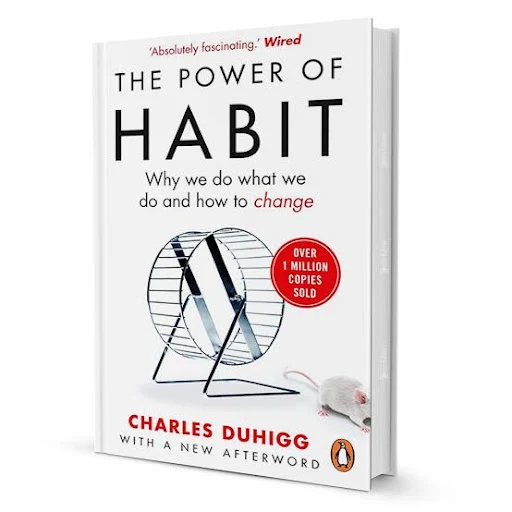Introduction: Why Habits Matter
In The Power of Habit, Charles Duhigg explores how habits work, why they exist, and how we can change them. He divides the book into three sections:
1. The Habits of Individuals
2. The Habits of Successful Organizations
3. The Habits of Societies
Duhigg argues that habits drive almost everything we do—both good and bad. By understanding how habits work, we can reprogram them to improve our lives, businesses, and communities.
---
Part 1: The Habits of Individuals
The Habit Loop: Cue → Routine → Reward
At the core of every habit is a neurological pattern called the habit loop, which consists of:
1. Cue – A trigger that tells your brain to start a behavior.
2. Routine – The behavior itself (good or bad).
3. Reward – A benefit that reinforces the habit.
Example: Smoking Habit
Cue: Feeling stressed.
Routine: Smoking a cigarette.
Reward: Temporary relaxation.
This loop makes habits automatic. Once a loop is formed, the brain stops fully participating in decision-making, which is why habits are so powerful.
The Golden Rule of Habit Change
You cannot erase a bad habit, but you can replace it with a better one. The key is to keep the cue and reward the same while changing the routine.
Example: Replacing a Junk Food Habit
Old Habit:
Cue: Feeling bored.
Routine: Eating chips.
Reward: Feeling satisfied.
New Habit:
Cue: Feeling bored.
Routine: Eating fruit.
Reward: Feeling satisfied.
By making small, conscious changes, we can reshape our behaviors over time.
Keystone Habits: Small Changes That Transform Everything
Keystone habits are behaviors that influence multiple areas of life. They create a domino effect, leading to significant positive changes.
Example: Exercise as a Keystone Habit
People who start exercising often develop better eating habits, sleep better, and perform better at work.
Other Keystone Habits:
Making your bed daily → Increases productivity.
Journaling → Improves mental clarity.
Practicing gratitude → Boosts happiness.
---
Part 2: The Habits of Successful Organizations
How Companies Use Habits to Influence Customers
Businesses exploit habits to drive sales. They use predictive analytics to understand customer behavior and create marketing strategies that trigger habitual purchases.
Example: Target’s Predictive Analytics
Target analyzed shopping habits to predict when women were pregnant and sent them personalized ads for baby products—before they even announced their pregnancy.
The Power of Crisis: When Organizations Change
Companies often resist change, but crises force them to rethink old habits.
Example: Paul O’Neill’s Leadership at Alcoa
When Paul O’Neill became CEO of Alcoa, he focused on one keystone habit: safety.
By prioritizing worker safety, he improved productivity, communication, and profitability.
The company’s market value increased from $3 billion to $27 billion.
Starbucks and Willpower Training
Starbucks trains employees to handle difficult customers by developing habit-based responses.
They use pre-planned routines to manage stressful situations.
Employees practice their responses until they become automatic.
This shows that willpower is like a muscle—it can be strengthened over time through habits.
---
Part 3: The Habits of Societies
Movements and Social Change: How Habits Shape Culture
Social movements follow the habit loop:
1. Cue: A triggering event.
2. Routine: Collective action.
3. Reward: A sense of purpose and belonging.
Example: The Montgomery Bus Boycott
Cue: Rosa Parks refused to give up her seat.
Routine: Mass protests and boycotts.
Reward: Civil rights progress.
This movement wasn’t spontaneous—it was built on existing social habits of community organization and activism.
How Habits Become Social Norms
When enough people adopt a habit, it becomes a cultural norm.
Companies, governments, and movements use this principle to drive large-scale change.
---
Applying The Power of Habit in Your Life
1. Identify Your Habit Loops
What are your cues, routines, and rewards?
Keep a habit journal to track them.
2. Change the Routine, Not the Cue or Reward
Keep the same trigger but replace the bad habit with a better one.
Example: Instead of scrolling social media when bored, read a book.
3. Use Keystone Habits to Transform Your Life
Focus on one powerful habit that influences multiple areas.
Example: Exercising daily improves discipline in other areas.
4. Strengthen Willpower Through Small Wins
Willpower grows with practice, like a muscle.
Set small, achievable goals to build momentum.
5. Create Social and Environmental Support
Surround yourself with people who reinforce good habits.
Modify your environment to make good habits easier (e.g., keep healthy snacks visible).
---
Conclusion: Small Habits, Big Results
The Power of Habit teaches that small habit changes lead to massive long-term success. Whether you want to be healthier, more productive, or financially successful, mastering
your habits is the key.
"First we make our habits, then our habits make us." – Charles Duhigg
